Ethical Issues in Employee Attrition: Causes, Impacts, and Solutions
VerifiedAdded on 2020/04/21
|15
|3622
|333
Essay
AI Summary
This essay delves into the multifaceted issue of employee attrition, examining the ethical dimensions that influence employee decisions and organizational practices. It begins by defining employee attrition and its various manifestations, such as resignation and retirement, while also acknowledging the economic motivations behind attrition strategies like layoffs. The discussion then explores the causes of employee attrition, including factors like job dissatisfaction, limited growth opportunities, and unethical management practices. The essay emphasizes the importance of ethical considerations in human resource management, including fair treatment, transparent communication, and adherence to company policies. It highlights the impact of unethical practices on employee morale, productivity, and overall organizational success, and underscores the importance of maintaining ethical values to reduce employee attrition. The paper concludes by suggesting strategies for improving employee retention and fostering a positive work environment, such as implementing corporate social responsibility initiatives and ensuring transparency in business operations. The essay emphasizes the interconnectedness of ethical behavior and business success, arguing that ethical practices are essential for long-term organizational health and employee well-being.
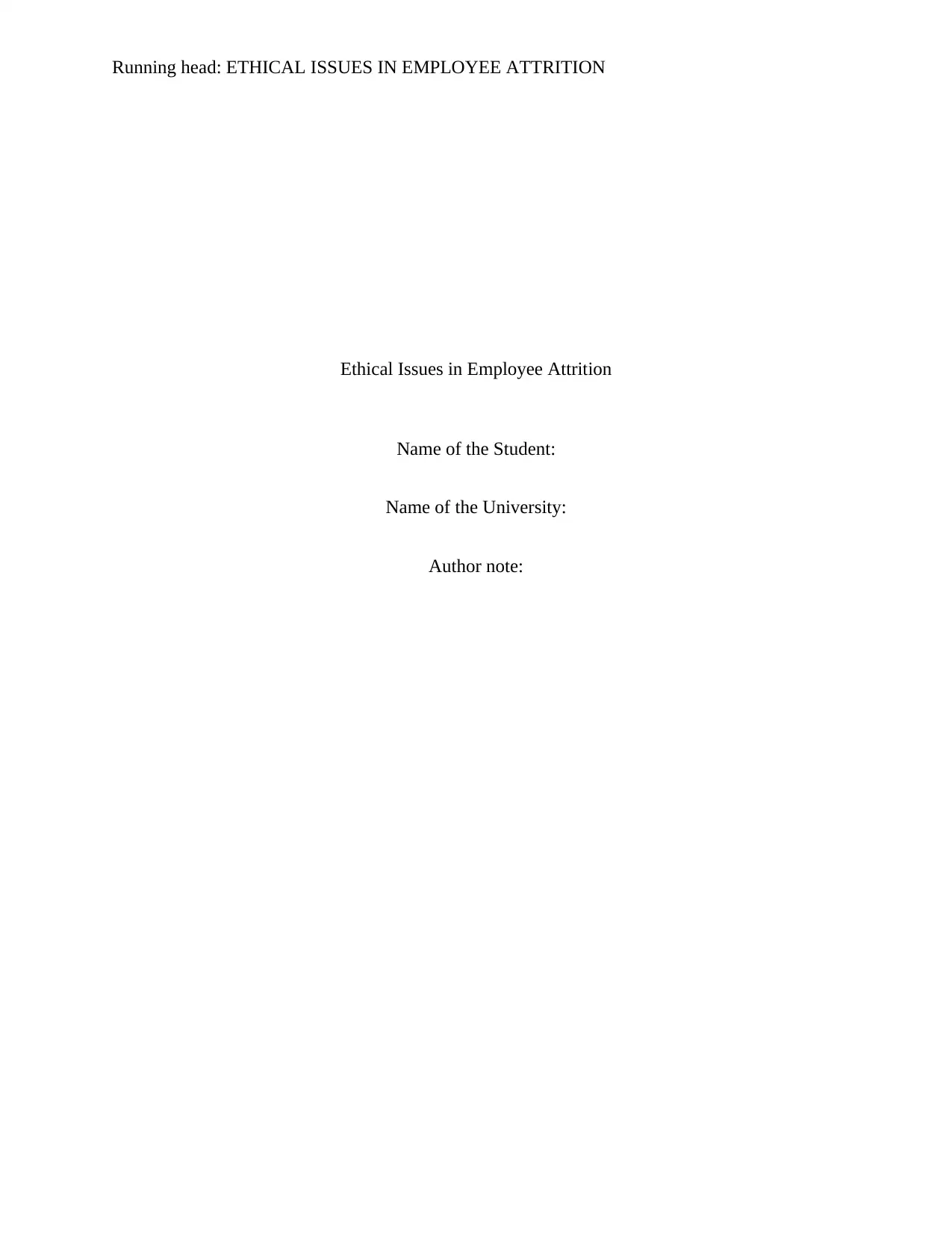
Running head: ETHICAL ISSUES IN EMPLOYEE ATTRITION
Ethical Issues in Employee Attrition
Name of the Student:
Name of the University:
Author note:
Ethical Issues in Employee Attrition
Name of the Student:
Name of the University:
Author note:
Paraphrase This Document
Need a fresh take? Get an instant paraphrase of this document with our AI Paraphraser
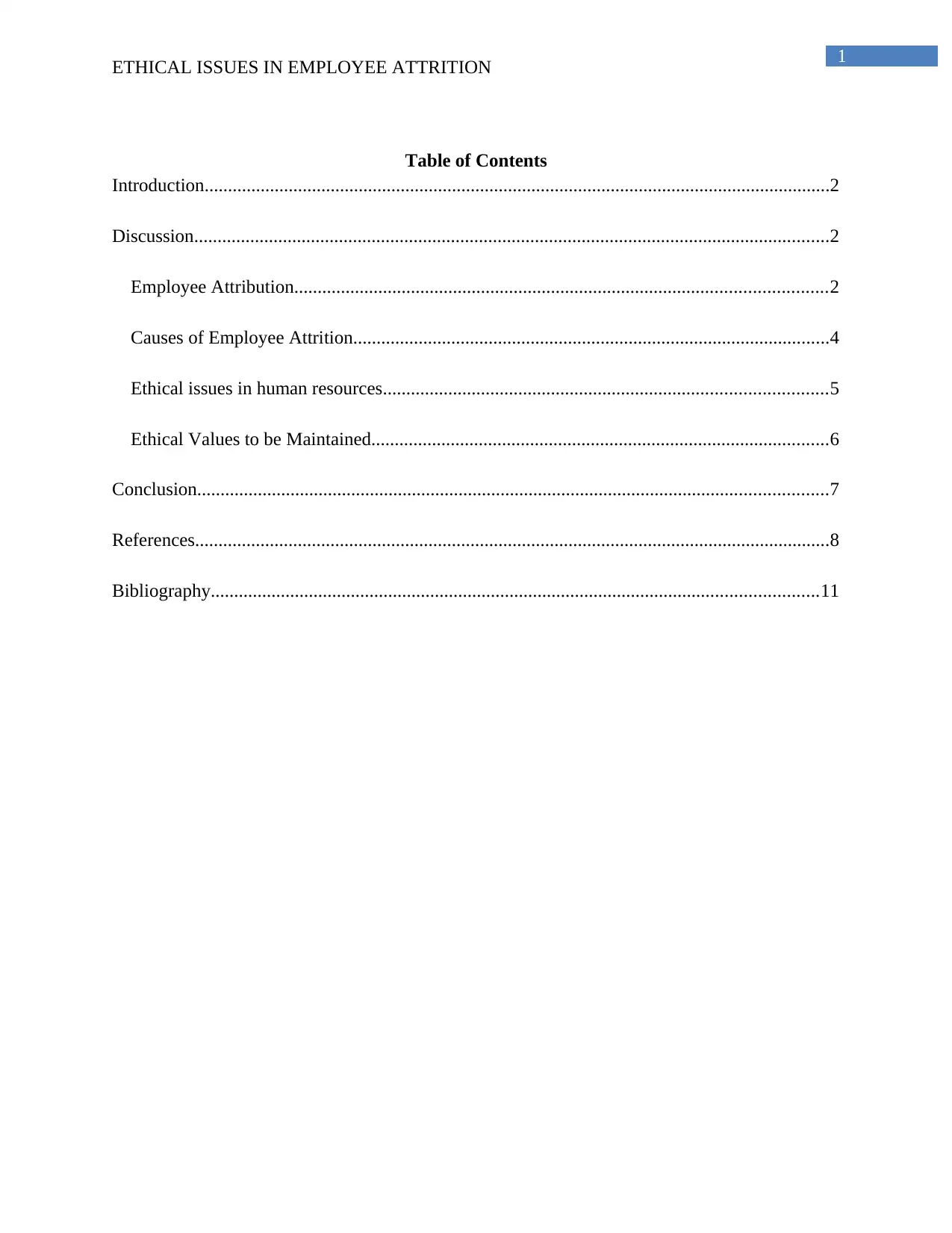
1
ETHICAL ISSUES IN EMPLOYEE ATTRITION
Table of Contents
Introduction......................................................................................................................................2
Discussion........................................................................................................................................2
Employee Attribution..................................................................................................................2
Causes of Employee Attrition......................................................................................................4
Ethical issues in human resources...............................................................................................5
Ethical Values to be Maintained..................................................................................................6
Conclusion.......................................................................................................................................7
References........................................................................................................................................8
Bibliography..................................................................................................................................11
ETHICAL ISSUES IN EMPLOYEE ATTRITION
Table of Contents
Introduction......................................................................................................................................2
Discussion........................................................................................................................................2
Employee Attribution..................................................................................................................2
Causes of Employee Attrition......................................................................................................4
Ethical issues in human resources...............................................................................................5
Ethical Values to be Maintained..................................................................................................6
Conclusion.......................................................................................................................................7
References........................................................................................................................................8
Bibliography..................................................................................................................................11
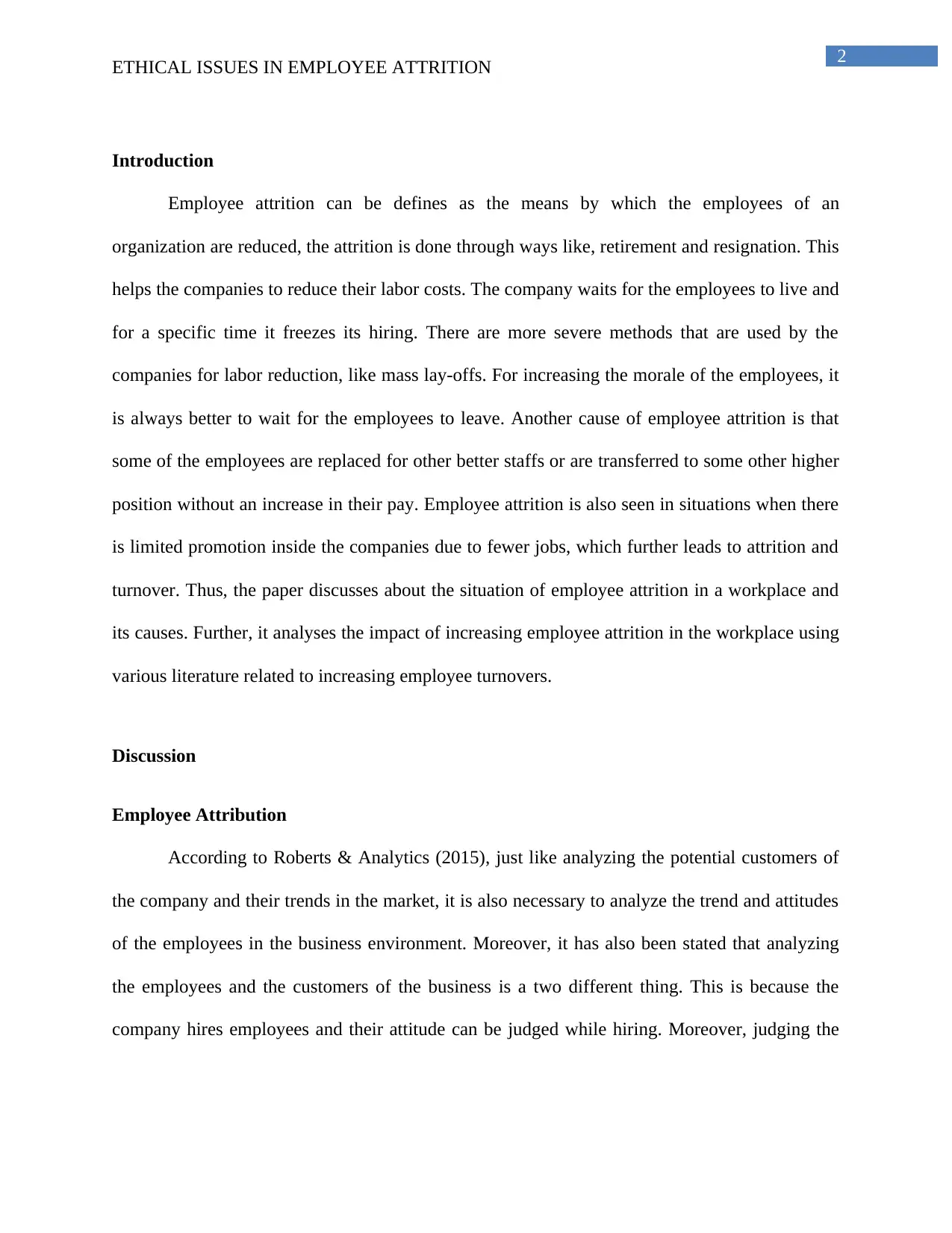
2
ETHICAL ISSUES IN EMPLOYEE ATTRITION
Introduction
Employee attrition can be defines as the means by which the employees of an
organization are reduced, the attrition is done through ways like, retirement and resignation. This
helps the companies to reduce their labor costs. The company waits for the employees to live and
for a specific time it freezes its hiring. There are more severe methods that are used by the
companies for labor reduction, like mass lay-offs. For increasing the morale of the employees, it
is always better to wait for the employees to leave. Another cause of employee attrition is that
some of the employees are replaced for other better staffs or are transferred to some other higher
position without an increase in their pay. Employee attrition is also seen in situations when there
is limited promotion inside the companies due to fewer jobs, which further leads to attrition and
turnover. Thus, the paper discusses about the situation of employee attrition in a workplace and
its causes. Further, it analyses the impact of increasing employee attrition in the workplace using
various literature related to increasing employee turnovers.
Discussion
Employee Attribution
According to Roberts & Analytics (2015), just like analyzing the potential customers of
the company and their trends in the market, it is also necessary to analyze the trend and attitudes
of the employees in the business environment. Moreover, it has also been stated that analyzing
the employees and the customers of the business is a two different thing. This is because the
company hires employees and their attitude can be judged while hiring. Moreover, judging the
ETHICAL ISSUES IN EMPLOYEE ATTRITION
Introduction
Employee attrition can be defines as the means by which the employees of an
organization are reduced, the attrition is done through ways like, retirement and resignation. This
helps the companies to reduce their labor costs. The company waits for the employees to live and
for a specific time it freezes its hiring. There are more severe methods that are used by the
companies for labor reduction, like mass lay-offs. For increasing the morale of the employees, it
is always better to wait for the employees to leave. Another cause of employee attrition is that
some of the employees are replaced for other better staffs or are transferred to some other higher
position without an increase in their pay. Employee attrition is also seen in situations when there
is limited promotion inside the companies due to fewer jobs, which further leads to attrition and
turnover. Thus, the paper discusses about the situation of employee attrition in a workplace and
its causes. Further, it analyses the impact of increasing employee attrition in the workplace using
various literature related to increasing employee turnovers.
Discussion
Employee Attribution
According to Roberts & Analytics (2015), just like analyzing the potential customers of
the company and their trends in the market, it is also necessary to analyze the trend and attitudes
of the employees in the business environment. Moreover, it has also been stated that analyzing
the employees and the customers of the business is a two different thing. This is because the
company hires employees and their attitude can be judged while hiring. Moreover, judging the
⊘ This is a preview!⊘
Do you want full access?
Subscribe today to unlock all pages.

Trusted by 1+ million students worldwide
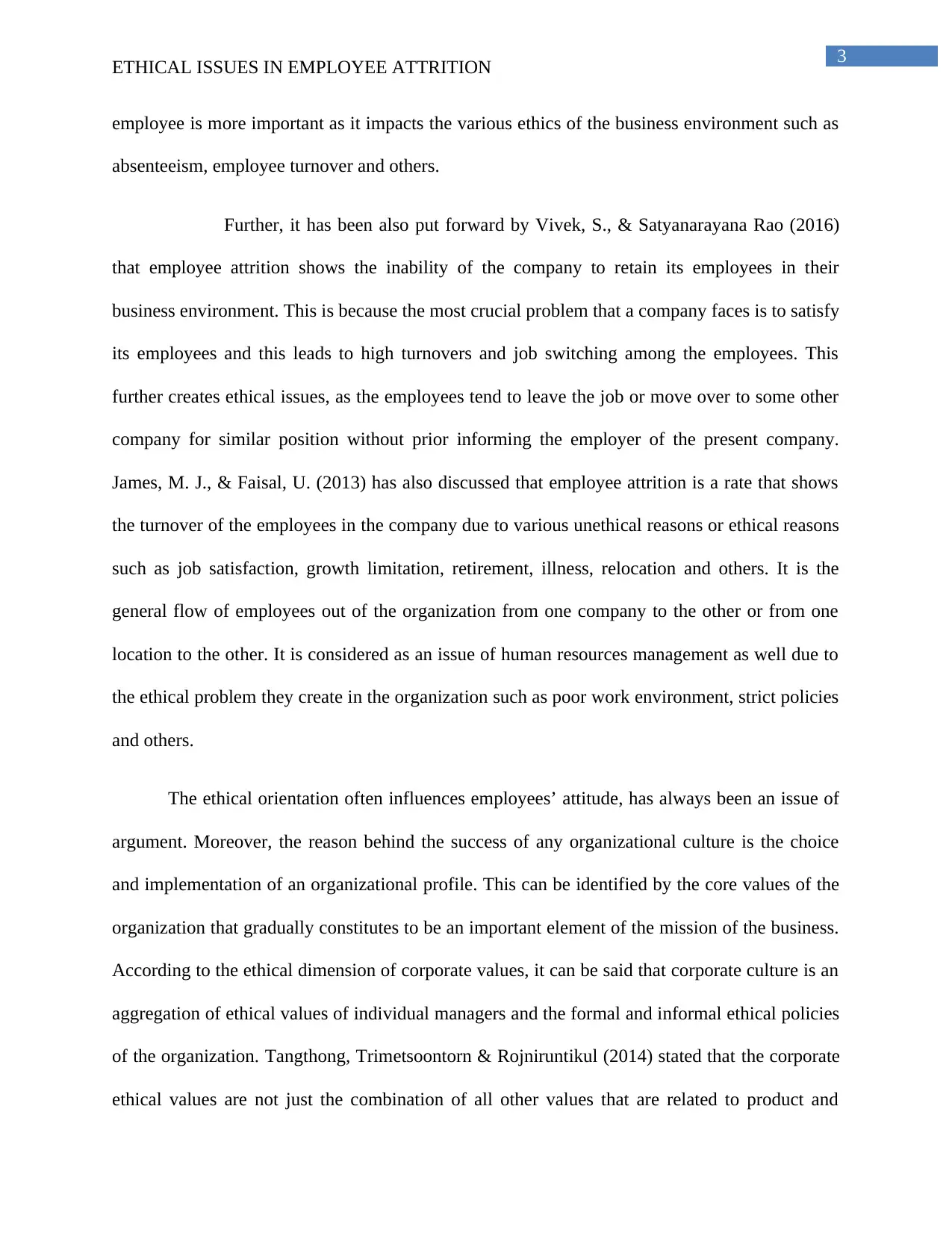
3
ETHICAL ISSUES IN EMPLOYEE ATTRITION
employee is more important as it impacts the various ethics of the business environment such as
absenteeism, employee turnover and others.
Further, it has been also put forward by Vivek, S., & Satyanarayana Rao (2016)
that employee attrition shows the inability of the company to retain its employees in their
business environment. This is because the most crucial problem that a company faces is to satisfy
its employees and this leads to high turnovers and job switching among the employees. This
further creates ethical issues, as the employees tend to leave the job or move over to some other
company for similar position without prior informing the employer of the present company.
James, M. J., & Faisal, U. (2013) has also discussed that employee attrition is a rate that shows
the turnover of the employees in the company due to various unethical reasons or ethical reasons
such as job satisfaction, growth limitation, retirement, illness, relocation and others. It is the
general flow of employees out of the organization from one company to the other or from one
location to the other. It is considered as an issue of human resources management as well due to
the ethical problem they create in the organization such as poor work environment, strict policies
and others.
The ethical orientation often influences employees’ attitude, has always been an issue of
argument. Moreover, the reason behind the success of any organizational culture is the choice
and implementation of an organizational profile. This can be identified by the core values of the
organization that gradually constitutes to be an important element of the mission of the business.
According to the ethical dimension of corporate values, it can be said that corporate culture is an
aggregation of ethical values of individual managers and the formal and informal ethical policies
of the organization. Tangthong, Trimetsoontorn & Rojniruntikul (2014) stated that the corporate
ethical values are not just the combination of all other values that are related to product and
ETHICAL ISSUES IN EMPLOYEE ATTRITION
employee is more important as it impacts the various ethics of the business environment such as
absenteeism, employee turnover and others.
Further, it has been also put forward by Vivek, S., & Satyanarayana Rao (2016)
that employee attrition shows the inability of the company to retain its employees in their
business environment. This is because the most crucial problem that a company faces is to satisfy
its employees and this leads to high turnovers and job switching among the employees. This
further creates ethical issues, as the employees tend to leave the job or move over to some other
company for similar position without prior informing the employer of the present company.
James, M. J., & Faisal, U. (2013) has also discussed that employee attrition is a rate that shows
the turnover of the employees in the company due to various unethical reasons or ethical reasons
such as job satisfaction, growth limitation, retirement, illness, relocation and others. It is the
general flow of employees out of the organization from one company to the other or from one
location to the other. It is considered as an issue of human resources management as well due to
the ethical problem they create in the organization such as poor work environment, strict policies
and others.
The ethical orientation often influences employees’ attitude, has always been an issue of
argument. Moreover, the reason behind the success of any organizational culture is the choice
and implementation of an organizational profile. This can be identified by the core values of the
organization that gradually constitutes to be an important element of the mission of the business.
According to the ethical dimension of corporate values, it can be said that corporate culture is an
aggregation of ethical values of individual managers and the formal and informal ethical policies
of the organization. Tangthong, Trimetsoontorn & Rojniruntikul (2014) stated that the corporate
ethical values are not just the combination of all other values that are related to product and
Paraphrase This Document
Need a fresh take? Get an instant paraphrase of this document with our AI Paraphraser
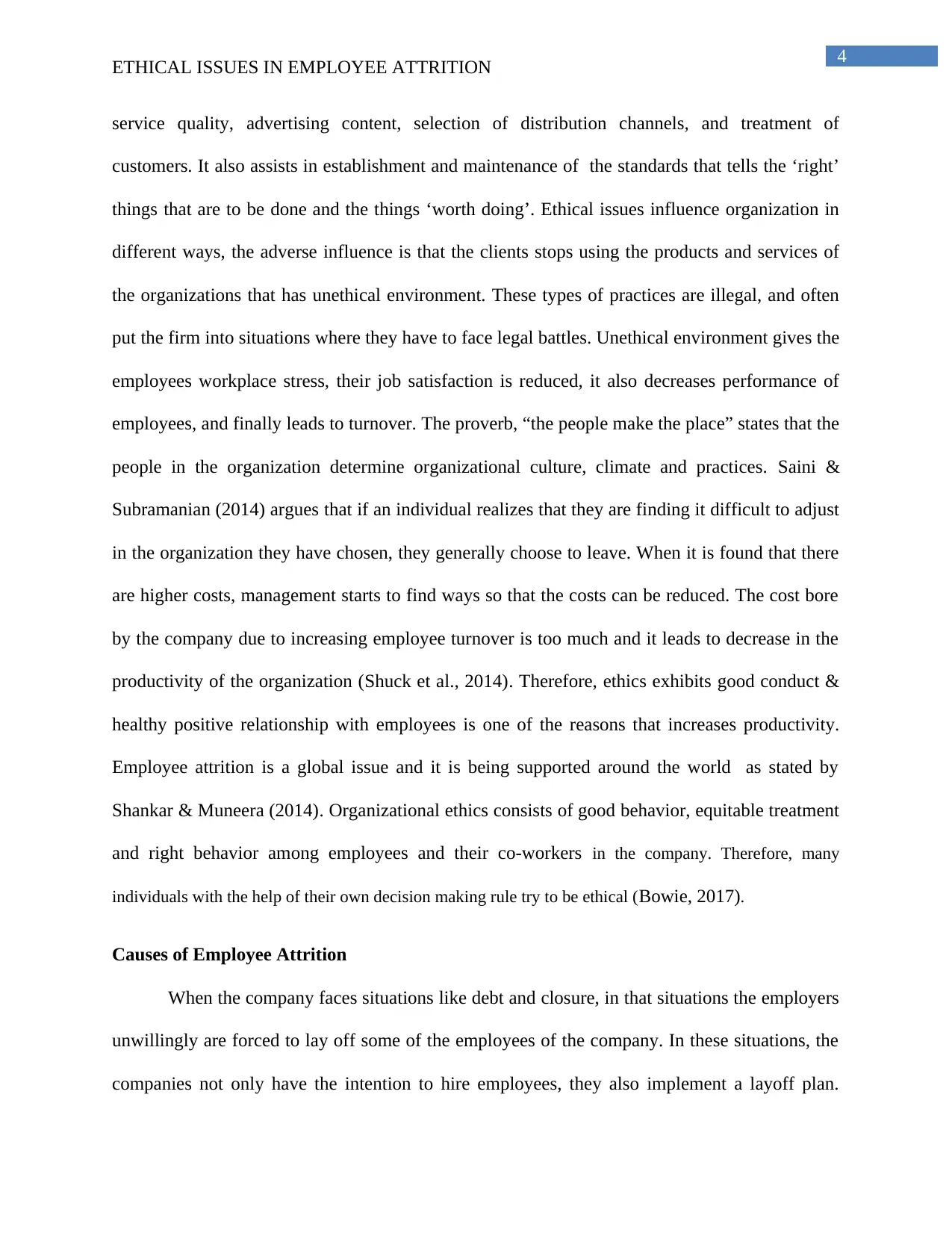
4
ETHICAL ISSUES IN EMPLOYEE ATTRITION
service quality, advertising content, selection of distribution channels, and treatment of
customers. It also assists in establishment and maintenance of the standards that tells the ‘right’
things that are to be done and the things ‘worth doing’. Ethical issues influence organization in
different ways, the adverse influence is that the clients stops using the products and services of
the organizations that has unethical environment. These types of practices are illegal, and often
put the firm into situations where they have to face legal battles. Unethical environment gives the
employees workplace stress, their job satisfaction is reduced, it also decreases performance of
employees, and finally leads to turnover. The proverb, “the people make the place” states that the
people in the organization determine organizational culture, climate and practices. Saini &
Subramanian (2014) argues that if an individual realizes that they are finding it difficult to adjust
in the organization they have chosen, they generally choose to leave. When it is found that there
are higher costs, management starts to find ways so that the costs can be reduced. The cost bore
by the company due to increasing employee turnover is too much and it leads to decrease in the
productivity of the organization (Shuck et al., 2014). Therefore, ethics exhibits good conduct &
healthy positive relationship with employees is one of the reasons that increases productivity.
Employee attrition is a global issue and it is being supported around the world as stated by
Shankar & Muneera (2014). Organizational ethics consists of good behavior, equitable treatment
and right behavior among employees and their co-workers in the company. Therefore, many
individuals with the help of their own decision making rule try to be ethical (Bowie, 2017).
Causes of Employee Attrition
When the company faces situations like debt and closure, in that situations the employers
unwillingly are forced to lay off some of the employees of the company. In these situations, the
companies not only have the intention to hire employees, they also implement a layoff plan.
ETHICAL ISSUES IN EMPLOYEE ATTRITION
service quality, advertising content, selection of distribution channels, and treatment of
customers. It also assists in establishment and maintenance of the standards that tells the ‘right’
things that are to be done and the things ‘worth doing’. Ethical issues influence organization in
different ways, the adverse influence is that the clients stops using the products and services of
the organizations that has unethical environment. These types of practices are illegal, and often
put the firm into situations where they have to face legal battles. Unethical environment gives the
employees workplace stress, their job satisfaction is reduced, it also decreases performance of
employees, and finally leads to turnover. The proverb, “the people make the place” states that the
people in the organization determine organizational culture, climate and practices. Saini &
Subramanian (2014) argues that if an individual realizes that they are finding it difficult to adjust
in the organization they have chosen, they generally choose to leave. When it is found that there
are higher costs, management starts to find ways so that the costs can be reduced. The cost bore
by the company due to increasing employee turnover is too much and it leads to decrease in the
productivity of the organization (Shuck et al., 2014). Therefore, ethics exhibits good conduct &
healthy positive relationship with employees is one of the reasons that increases productivity.
Employee attrition is a global issue and it is being supported around the world as stated by
Shankar & Muneera (2014). Organizational ethics consists of good behavior, equitable treatment
and right behavior among employees and their co-workers in the company. Therefore, many
individuals with the help of their own decision making rule try to be ethical (Bowie, 2017).
Causes of Employee Attrition
When the company faces situations like debt and closure, in that situations the employers
unwillingly are forced to lay off some of the employees of the company. In these situations, the
companies not only have the intention to hire employees, they also implement a layoff plan.
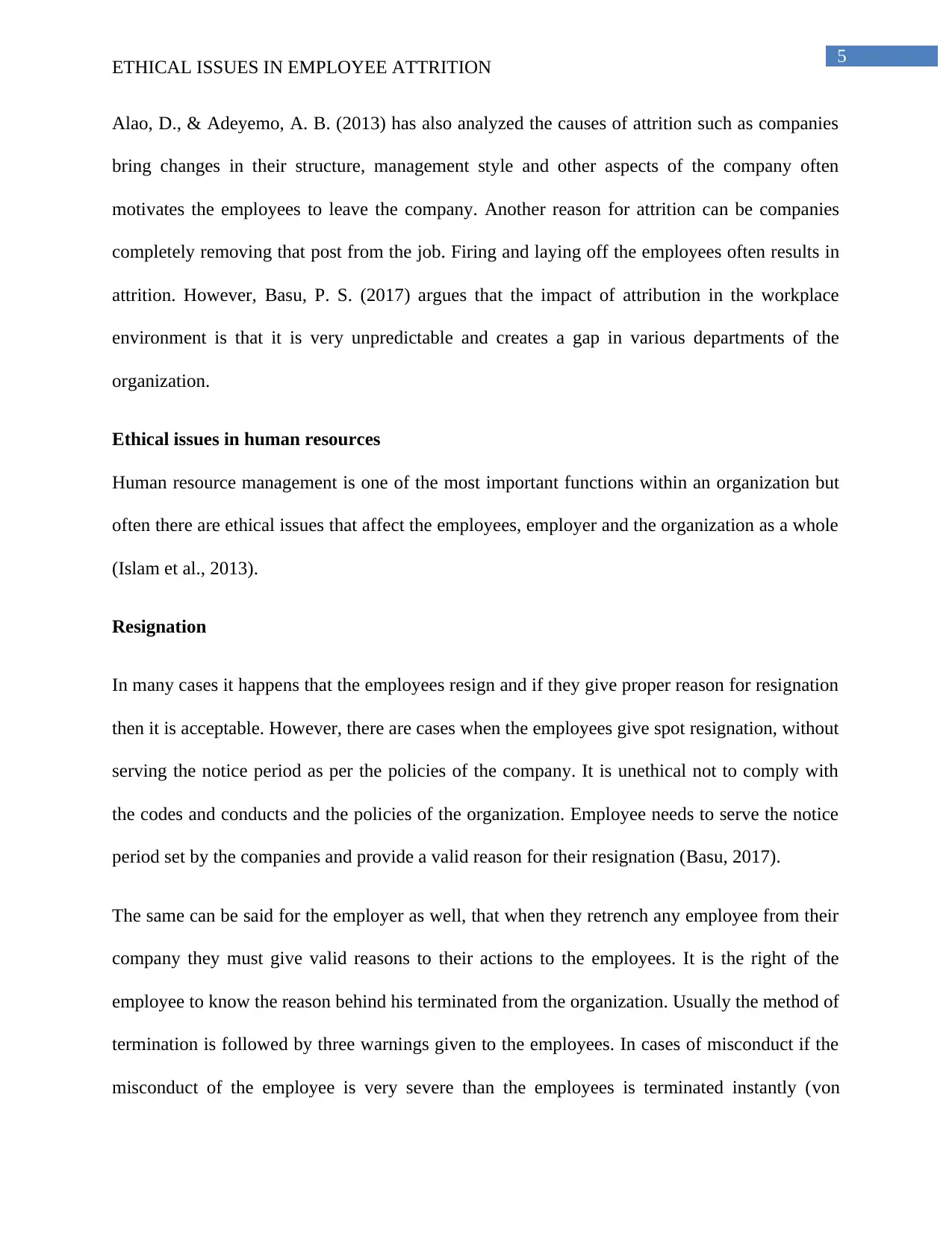
5
ETHICAL ISSUES IN EMPLOYEE ATTRITION
Alao, D., & Adeyemo, A. B. (2013) has also analyzed the causes of attrition such as companies
bring changes in their structure, management style and other aspects of the company often
motivates the employees to leave the company. Another reason for attrition can be companies
completely removing that post from the job. Firing and laying off the employees often results in
attrition. However, Basu, P. S. (2017) argues that the impact of attribution in the workplace
environment is that it is very unpredictable and creates a gap in various departments of the
organization.
Ethical issues in human resources
Human resource management is one of the most important functions within an organization but
often there are ethical issues that affect the employees, employer and the organization as a whole
(Islam et al., 2013).
Resignation
In many cases it happens that the employees resign and if they give proper reason for resignation
then it is acceptable. However, there are cases when the employees give spot resignation, without
serving the notice period as per the policies of the company. It is unethical not to comply with
the codes and conducts and the policies of the organization. Employee needs to serve the notice
period set by the companies and provide a valid reason for their resignation (Basu, 2017).
The same can be said for the employer as well, that when they retrench any employee from their
company they must give valid reasons to their actions to the employees. It is the right of the
employee to know the reason behind his terminated from the organization. Usually the method of
termination is followed by three warnings given to the employees. In cases of misconduct if the
misconduct of the employee is very severe than the employees is terminated instantly (von
ETHICAL ISSUES IN EMPLOYEE ATTRITION
Alao, D., & Adeyemo, A. B. (2013) has also analyzed the causes of attrition such as companies
bring changes in their structure, management style and other aspects of the company often
motivates the employees to leave the company. Another reason for attrition can be companies
completely removing that post from the job. Firing and laying off the employees often results in
attrition. However, Basu, P. S. (2017) argues that the impact of attribution in the workplace
environment is that it is very unpredictable and creates a gap in various departments of the
organization.
Ethical issues in human resources
Human resource management is one of the most important functions within an organization but
often there are ethical issues that affect the employees, employer and the organization as a whole
(Islam et al., 2013).
Resignation
In many cases it happens that the employees resign and if they give proper reason for resignation
then it is acceptable. However, there are cases when the employees give spot resignation, without
serving the notice period as per the policies of the company. It is unethical not to comply with
the codes and conducts and the policies of the organization. Employee needs to serve the notice
period set by the companies and provide a valid reason for their resignation (Basu, 2017).
The same can be said for the employer as well, that when they retrench any employee from their
company they must give valid reasons to their actions to the employees. It is the right of the
employee to know the reason behind his terminated from the organization. Usually the method of
termination is followed by three warnings given to the employees. In cases of misconduct if the
misconduct of the employee is very severe than the employees is terminated instantly (von
⊘ This is a preview!⊘
Do you want full access?
Subscribe today to unlock all pages.

Trusted by 1+ million students worldwide
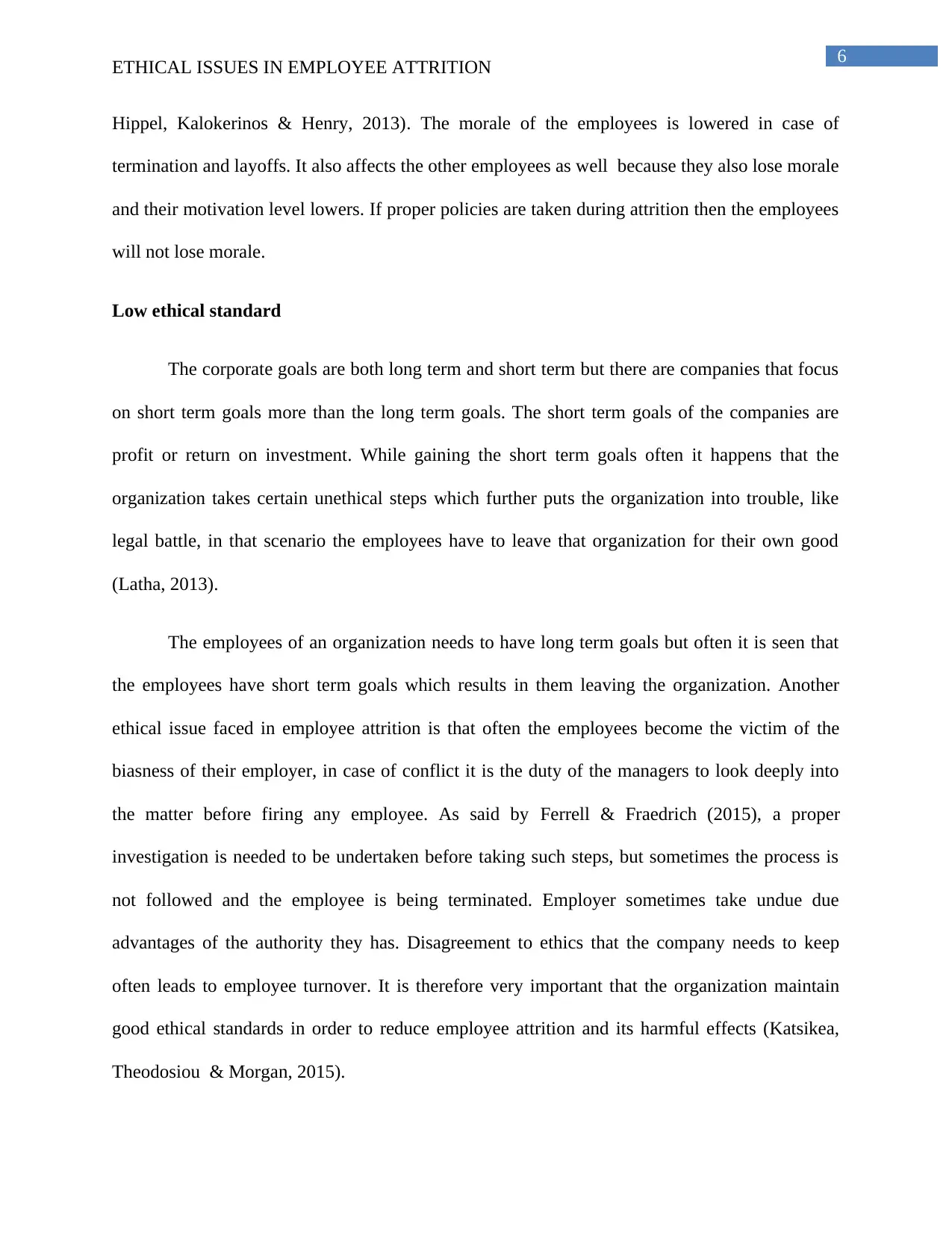
6
ETHICAL ISSUES IN EMPLOYEE ATTRITION
Hippel, Kalokerinos & Henry, 2013). The morale of the employees is lowered in case of
termination and layoffs. It also affects the other employees as well because they also lose morale
and their motivation level lowers. If proper policies are taken during attrition then the employees
will not lose morale.
Low ethical standard
The corporate goals are both long term and short term but there are companies that focus
on short term goals more than the long term goals. The short term goals of the companies are
profit or return on investment. While gaining the short term goals often it happens that the
organization takes certain unethical steps which further puts the organization into trouble, like
legal battle, in that scenario the employees have to leave that organization for their own good
(Latha, 2013).
The employees of an organization needs to have long term goals but often it is seen that
the employees have short term goals which results in them leaving the organization. Another
ethical issue faced in employee attrition is that often the employees become the victim of the
biasness of their employer, in case of conflict it is the duty of the managers to look deeply into
the matter before firing any employee. As said by Ferrell & Fraedrich (2015), a proper
investigation is needed to be undertaken before taking such steps, but sometimes the process is
not followed and the employee is being terminated. Employer sometimes take undue due
advantages of the authority they has. Disagreement to ethics that the company needs to keep
often leads to employee turnover. It is therefore very important that the organization maintain
good ethical standards in order to reduce employee attrition and its harmful effects (Katsikea,
Theodosiou & Morgan, 2015).
ETHICAL ISSUES IN EMPLOYEE ATTRITION
Hippel, Kalokerinos & Henry, 2013). The morale of the employees is lowered in case of
termination and layoffs. It also affects the other employees as well because they also lose morale
and their motivation level lowers. If proper policies are taken during attrition then the employees
will not lose morale.
Low ethical standard
The corporate goals are both long term and short term but there are companies that focus
on short term goals more than the long term goals. The short term goals of the companies are
profit or return on investment. While gaining the short term goals often it happens that the
organization takes certain unethical steps which further puts the organization into trouble, like
legal battle, in that scenario the employees have to leave that organization for their own good
(Latha, 2013).
The employees of an organization needs to have long term goals but often it is seen that
the employees have short term goals which results in them leaving the organization. Another
ethical issue faced in employee attrition is that often the employees become the victim of the
biasness of their employer, in case of conflict it is the duty of the managers to look deeply into
the matter before firing any employee. As said by Ferrell & Fraedrich (2015), a proper
investigation is needed to be undertaken before taking such steps, but sometimes the process is
not followed and the employee is being terminated. Employer sometimes take undue due
advantages of the authority they has. Disagreement to ethics that the company needs to keep
often leads to employee turnover. It is therefore very important that the organization maintain
good ethical standards in order to reduce employee attrition and its harmful effects (Katsikea,
Theodosiou & Morgan, 2015).
Paraphrase This Document
Need a fresh take? Get an instant paraphrase of this document with our AI Paraphraser
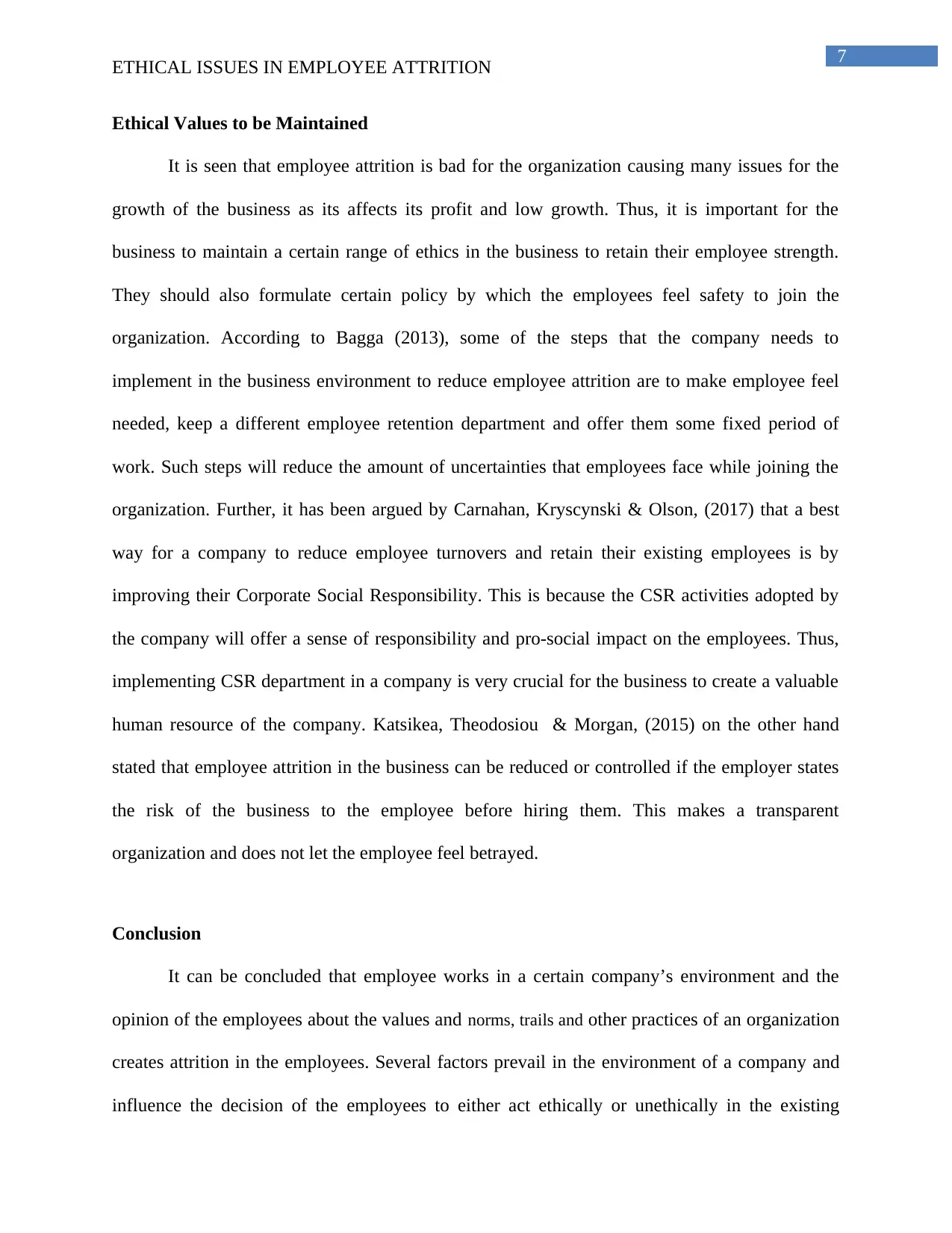
7
ETHICAL ISSUES IN EMPLOYEE ATTRITION
Ethical Values to be Maintained
It is seen that employee attrition is bad for the organization causing many issues for the
growth of the business as its affects its profit and low growth. Thus, it is important for the
business to maintain a certain range of ethics in the business to retain their employee strength.
They should also formulate certain policy by which the employees feel safety to join the
organization. According to Bagga (2013), some of the steps that the company needs to
implement in the business environment to reduce employee attrition are to make employee feel
needed, keep a different employee retention department and offer them some fixed period of
work. Such steps will reduce the amount of uncertainties that employees face while joining the
organization. Further, it has been argued by Carnahan, Kryscynski & Olson, (2017) that a best
way for a company to reduce employee turnovers and retain their existing employees is by
improving their Corporate Social Responsibility. This is because the CSR activities adopted by
the company will offer a sense of responsibility and pro-social impact on the employees. Thus,
implementing CSR department in a company is very crucial for the business to create a valuable
human resource of the company. Katsikea, Theodosiou & Morgan, (2015) on the other hand
stated that employee attrition in the business can be reduced or controlled if the employer states
the risk of the business to the employee before hiring them. This makes a transparent
organization and does not let the employee feel betrayed.
Conclusion
It can be concluded that employee works in a certain company’s environment and the
opinion of the employees about the values and norms, trails and other practices of an organization
creates attrition in the employees. Several factors prevail in the environment of a company and
influence the decision of the employees to either act ethically or unethically in the existing
ETHICAL ISSUES IN EMPLOYEE ATTRITION
Ethical Values to be Maintained
It is seen that employee attrition is bad for the organization causing many issues for the
growth of the business as its affects its profit and low growth. Thus, it is important for the
business to maintain a certain range of ethics in the business to retain their employee strength.
They should also formulate certain policy by which the employees feel safety to join the
organization. According to Bagga (2013), some of the steps that the company needs to
implement in the business environment to reduce employee attrition are to make employee feel
needed, keep a different employee retention department and offer them some fixed period of
work. Such steps will reduce the amount of uncertainties that employees face while joining the
organization. Further, it has been argued by Carnahan, Kryscynski & Olson, (2017) that a best
way for a company to reduce employee turnovers and retain their existing employees is by
improving their Corporate Social Responsibility. This is because the CSR activities adopted by
the company will offer a sense of responsibility and pro-social impact on the employees. Thus,
implementing CSR department in a company is very crucial for the business to create a valuable
human resource of the company. Katsikea, Theodosiou & Morgan, (2015) on the other hand
stated that employee attrition in the business can be reduced or controlled if the employer states
the risk of the business to the employee before hiring them. This makes a transparent
organization and does not let the employee feel betrayed.
Conclusion
It can be concluded that employee works in a certain company’s environment and the
opinion of the employees about the values and norms, trails and other practices of an organization
creates attrition in the employees. Several factors prevail in the environment of a company and
influence the decision of the employees to either act ethically or unethically in the existing

8
ETHICAL ISSUES IN EMPLOYEE ATTRITION
business environment. However, maintain a good business ethics will reduce employee attrition
automatically.
ETHICAL ISSUES IN EMPLOYEE ATTRITION
business environment. However, maintain a good business ethics will reduce employee attrition
automatically.
⊘ This is a preview!⊘
Do you want full access?
Subscribe today to unlock all pages.

Trusted by 1+ million students worldwide
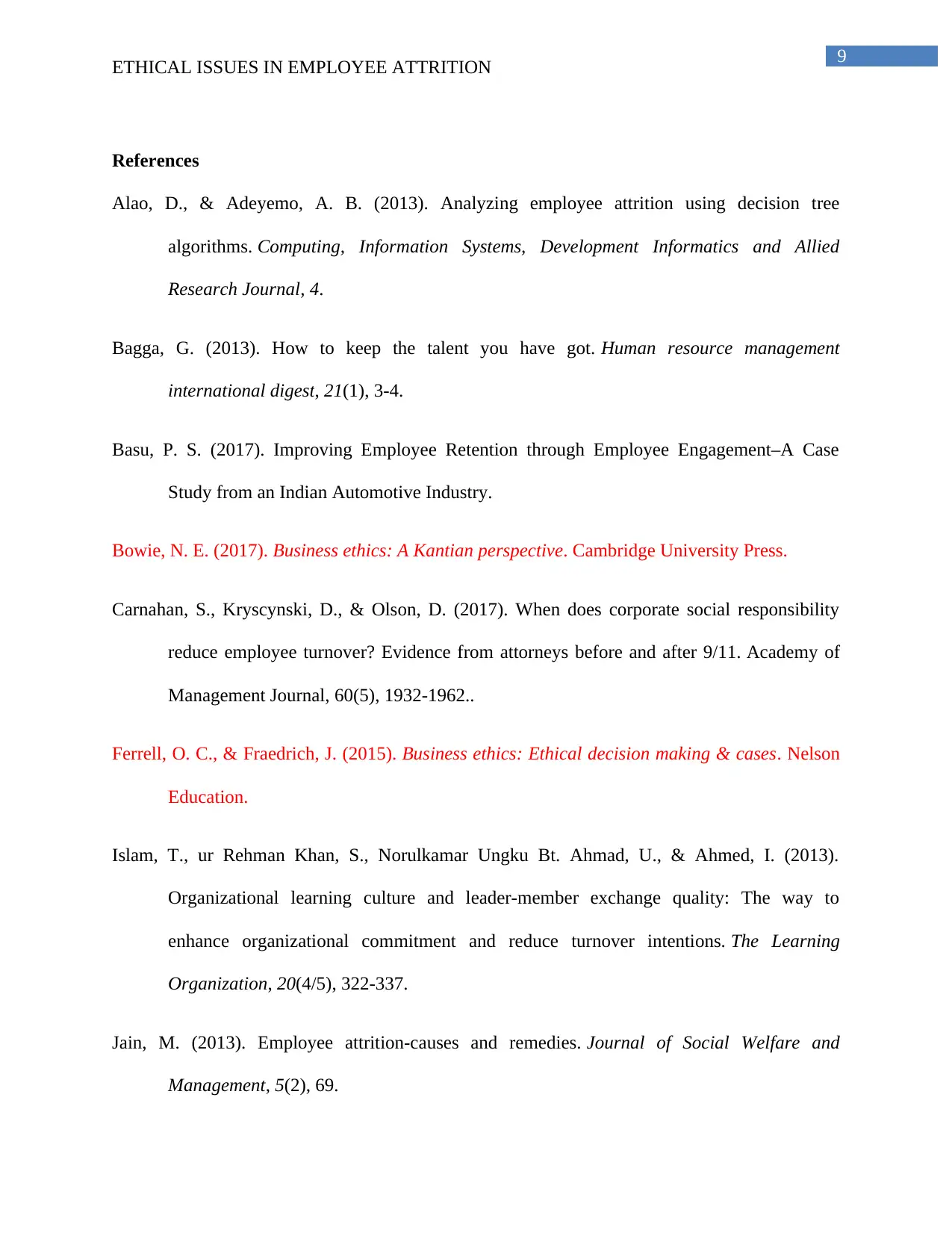
9
ETHICAL ISSUES IN EMPLOYEE ATTRITION
References
Alao, D., & Adeyemo, A. B. (2013). Analyzing employee attrition using decision tree
algorithms. Computing, Information Systems, Development Informatics and Allied
Research Journal, 4.
Bagga, G. (2013). How to keep the talent you have got. Human resource management
international digest, 21(1), 3-4.
Basu, P. S. (2017). Improving Employee Retention through Employee Engagement–A Case
Study from an Indian Automotive Industry.
Bowie, N. E. (2017). Business ethics: A Kantian perspective. Cambridge University Press.
Carnahan, S., Kryscynski, D., & Olson, D. (2017). When does corporate social responsibility
reduce employee turnover? Evidence from attorneys before and after 9/11. Academy of
Management Journal, 60(5), 1932-1962..
Ferrell, O. C., & Fraedrich, J. (2015). Business ethics: Ethical decision making & cases. Nelson
Education.
Islam, T., ur Rehman Khan, S., Norulkamar Ungku Bt. Ahmad, U., & Ahmed, I. (2013).
Organizational learning culture and leader-member exchange quality: The way to
enhance organizational commitment and reduce turnover intentions. The Learning
Organization, 20(4/5), 322-337.
Jain, M. (2013). Employee attrition-causes and remedies. Journal of Social Welfare and
Management, 5(2), 69.
ETHICAL ISSUES IN EMPLOYEE ATTRITION
References
Alao, D., & Adeyemo, A. B. (2013). Analyzing employee attrition using decision tree
algorithms. Computing, Information Systems, Development Informatics and Allied
Research Journal, 4.
Bagga, G. (2013). How to keep the talent you have got. Human resource management
international digest, 21(1), 3-4.
Basu, P. S. (2017). Improving Employee Retention through Employee Engagement–A Case
Study from an Indian Automotive Industry.
Bowie, N. E. (2017). Business ethics: A Kantian perspective. Cambridge University Press.
Carnahan, S., Kryscynski, D., & Olson, D. (2017). When does corporate social responsibility
reduce employee turnover? Evidence from attorneys before and after 9/11. Academy of
Management Journal, 60(5), 1932-1962..
Ferrell, O. C., & Fraedrich, J. (2015). Business ethics: Ethical decision making & cases. Nelson
Education.
Islam, T., ur Rehman Khan, S., Norulkamar Ungku Bt. Ahmad, U., & Ahmed, I. (2013).
Organizational learning culture and leader-member exchange quality: The way to
enhance organizational commitment and reduce turnover intentions. The Learning
Organization, 20(4/5), 322-337.
Jain, M. (2013). Employee attrition-causes and remedies. Journal of Social Welfare and
Management, 5(2), 69.
Paraphrase This Document
Need a fresh take? Get an instant paraphrase of this document with our AI Paraphraser
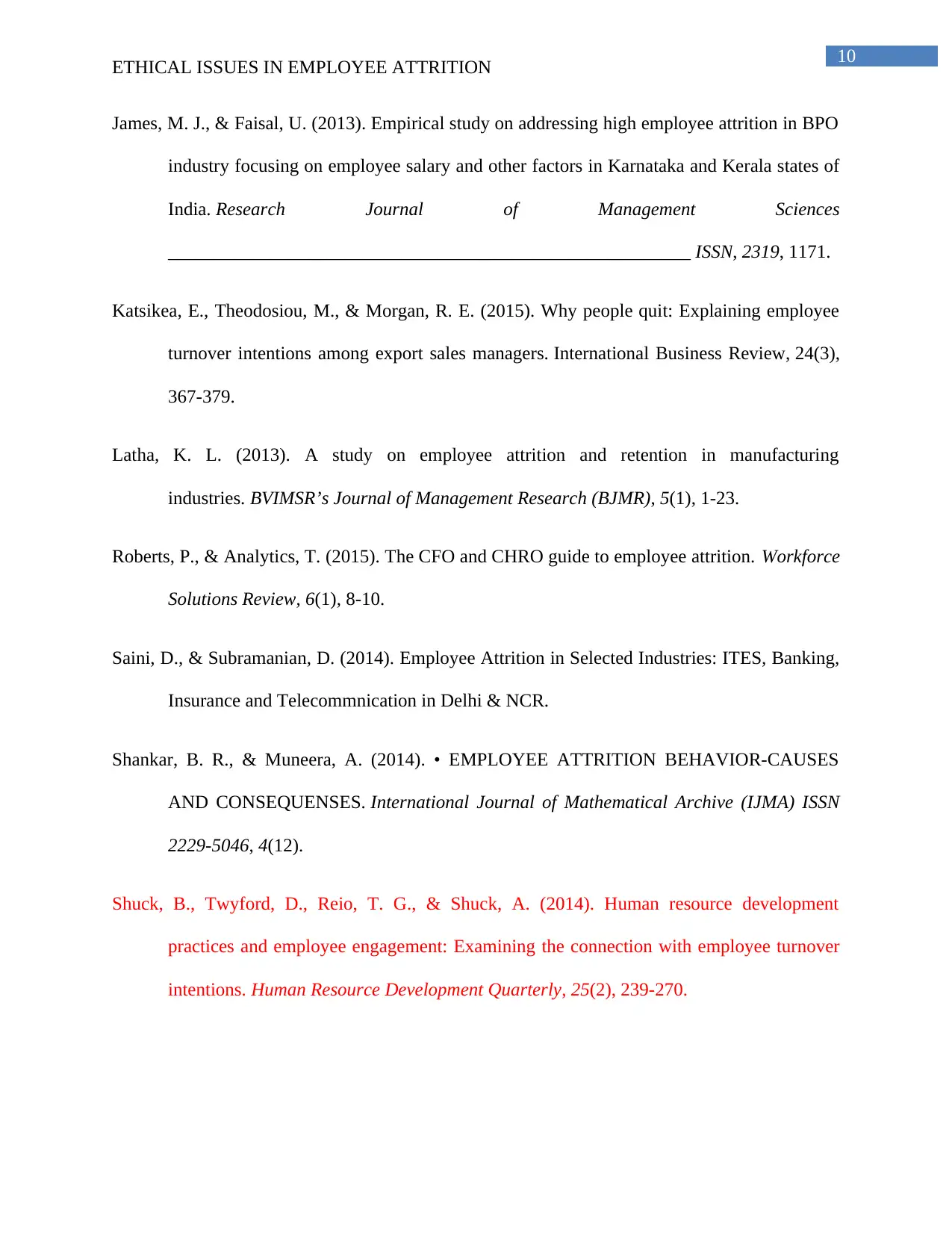
10
ETHICAL ISSUES IN EMPLOYEE ATTRITION
James, M. J., & Faisal, U. (2013). Empirical study on addressing high employee attrition in BPO
industry focusing on employee salary and other factors in Karnataka and Kerala states of
India. Research Journal of Management Sciences
________________________________________________________ ISSN, 2319, 1171.
Katsikea, E., Theodosiou, M., & Morgan, R. E. (2015). Why people quit: Explaining employee
turnover intentions among export sales managers. International Business Review, 24(3),
367-379.
Latha, K. L. (2013). A study on employee attrition and retention in manufacturing
industries. BVIMSR’s Journal of Management Research (BJMR), 5(1), 1-23.
Roberts, P., & Analytics, T. (2015). The CFO and CHRO guide to employee attrition. Workforce
Solutions Review, 6(1), 8-10.
Saini, D., & Subramanian, D. (2014). Employee Attrition in Selected Industries: ITES, Banking,
Insurance and Telecommnication in Delhi & NCR.
Shankar, B. R., & Muneera, A. (2014). • EMPLOYEE ATTRITION BEHAVIOR-CAUSES
AND CONSEQUENSES. International Journal of Mathematical Archive (IJMA) ISSN
2229-5046, 4(12).
Shuck, B., Twyford, D., Reio, T. G., & Shuck, A. (2014). Human resource development
practices and employee engagement: Examining the connection with employee turnover
intentions. Human Resource Development Quarterly, 25(2), 239-270.
ETHICAL ISSUES IN EMPLOYEE ATTRITION
James, M. J., & Faisal, U. (2013). Empirical study on addressing high employee attrition in BPO
industry focusing on employee salary and other factors in Karnataka and Kerala states of
India. Research Journal of Management Sciences
________________________________________________________ ISSN, 2319, 1171.
Katsikea, E., Theodosiou, M., & Morgan, R. E. (2015). Why people quit: Explaining employee
turnover intentions among export sales managers. International Business Review, 24(3),
367-379.
Latha, K. L. (2013). A study on employee attrition and retention in manufacturing
industries. BVIMSR’s Journal of Management Research (BJMR), 5(1), 1-23.
Roberts, P., & Analytics, T. (2015). The CFO and CHRO guide to employee attrition. Workforce
Solutions Review, 6(1), 8-10.
Saini, D., & Subramanian, D. (2014). Employee Attrition in Selected Industries: ITES, Banking,
Insurance and Telecommnication in Delhi & NCR.
Shankar, B. R., & Muneera, A. (2014). • EMPLOYEE ATTRITION BEHAVIOR-CAUSES
AND CONSEQUENSES. International Journal of Mathematical Archive (IJMA) ISSN
2229-5046, 4(12).
Shuck, B., Twyford, D., Reio, T. G., & Shuck, A. (2014). Human resource development
practices and employee engagement: Examining the connection with employee turnover
intentions. Human Resource Development Quarterly, 25(2), 239-270.
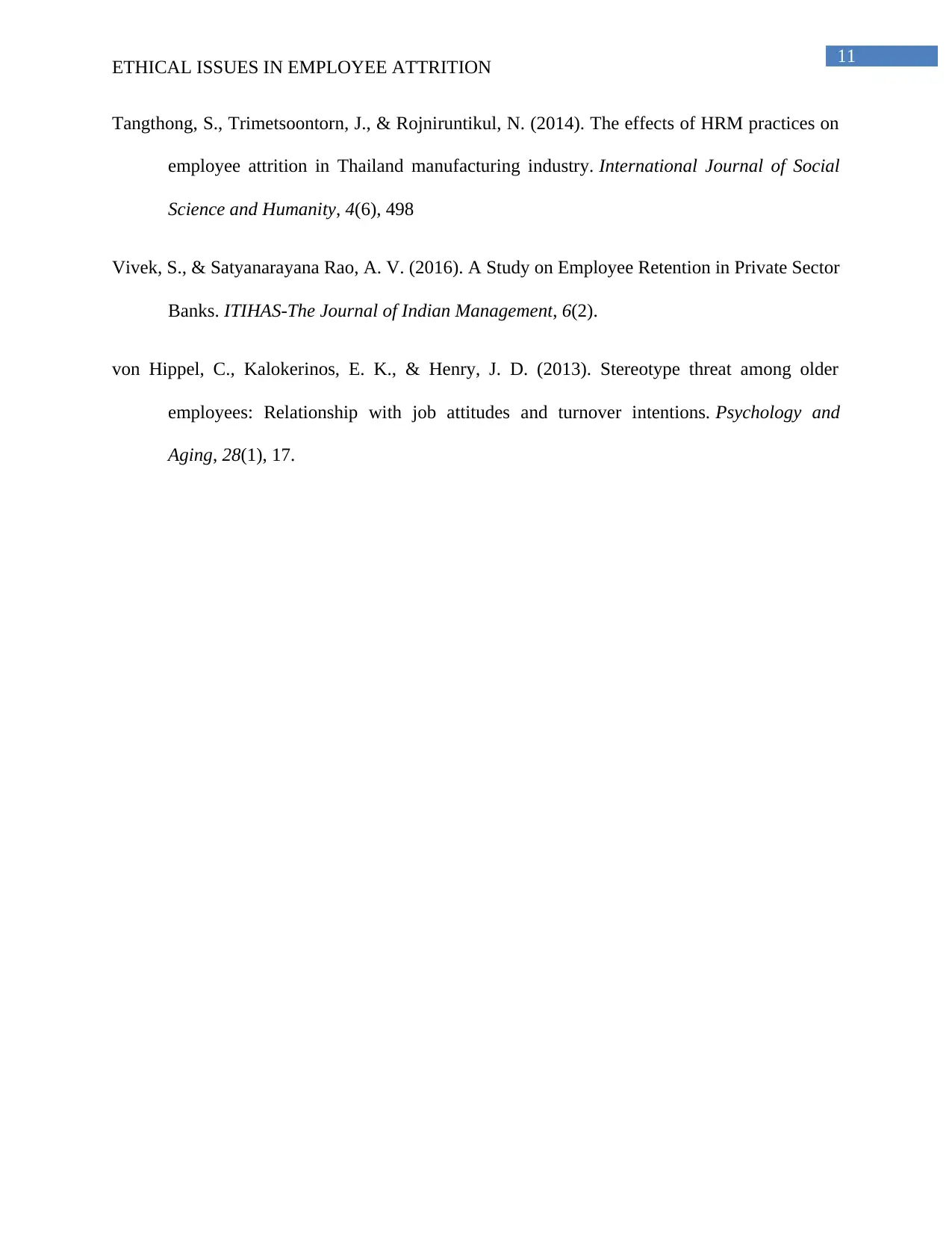
11
ETHICAL ISSUES IN EMPLOYEE ATTRITION
Tangthong, S., Trimetsoontorn, J., & Rojniruntikul, N. (2014). The effects of HRM practices on
employee attrition in Thailand manufacturing industry. International Journal of Social
Science and Humanity, 4(6), 498
Vivek, S., & Satyanarayana Rao, A. V. (2016). A Study on Employee Retention in Private Sector
Banks. ITIHAS-The Journal of Indian Management, 6(2).
von Hippel, C., Kalokerinos, E. K., & Henry, J. D. (2013). Stereotype threat among older
employees: Relationship with job attitudes and turnover intentions. Psychology and
Aging, 28(1), 17.
ETHICAL ISSUES IN EMPLOYEE ATTRITION
Tangthong, S., Trimetsoontorn, J., & Rojniruntikul, N. (2014). The effects of HRM practices on
employee attrition in Thailand manufacturing industry. International Journal of Social
Science and Humanity, 4(6), 498
Vivek, S., & Satyanarayana Rao, A. V. (2016). A Study on Employee Retention in Private Sector
Banks. ITIHAS-The Journal of Indian Management, 6(2).
von Hippel, C., Kalokerinos, E. K., & Henry, J. D. (2013). Stereotype threat among older
employees: Relationship with job attitudes and turnover intentions. Psychology and
Aging, 28(1), 17.
⊘ This is a preview!⊘
Do you want full access?
Subscribe today to unlock all pages.

Trusted by 1+ million students worldwide
1 out of 15
Related Documents
Your All-in-One AI-Powered Toolkit for Academic Success.
+13062052269
info@desklib.com
Available 24*7 on WhatsApp / Email
![[object Object]](/_next/static/media/star-bottom.7253800d.svg)
Unlock your academic potential
Copyright © 2020–2025 A2Z Services. All Rights Reserved. Developed and managed by ZUCOL.





